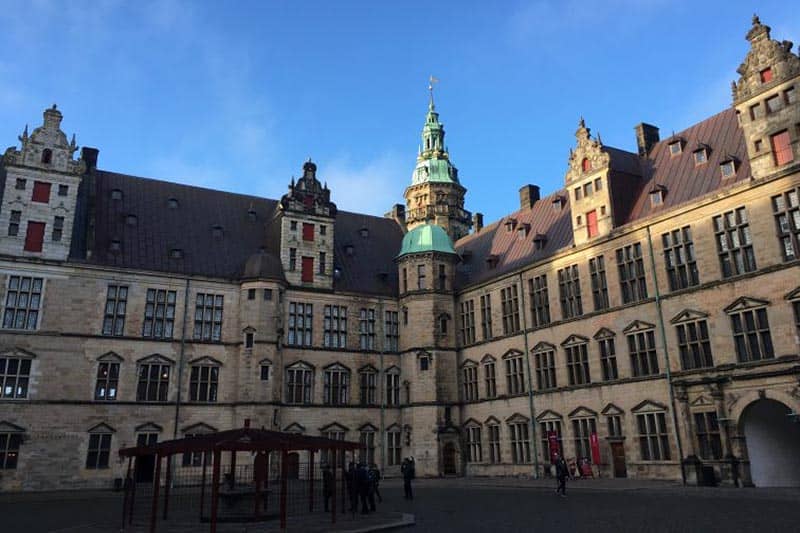
Helsingor, Denmark: Where Quaint meets Modern
By Susmita Sengupta
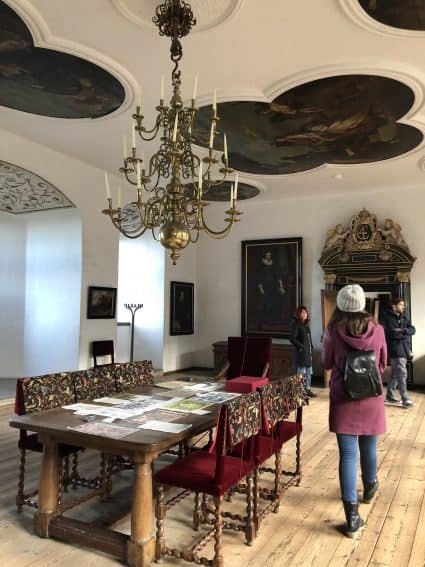
About an hour from Copenhagen, Denmark is the small city of Helsingor, the setting of the most famous Danish castle, Kronborg Castle, a UNESCO World Heritage Site since 2000 and recognized universally as Elsinore Castle from Shakespeare’s Hamlet.
Helsingor is easily reached from Copenhagen by car, train, bus and day-trip excursion tours. We took a regional express train and reached Helsingor in about 45 minutes on a sunny and cold November morning.
The castle is about a ten-minute walk from the train station and we joined a few other tourists, walking past the ferry terminal from where ferries leave for nearby Sweden.
The blue waters of the Øresund glittered in the sun and there in the backdrop loomed Kronborg Castle with its distinctive green spires.
History of the castle
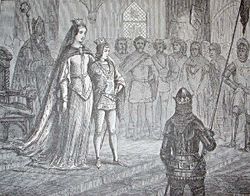
Kronborg castle sits at the narrowest point of the Øresund, the strait between present-day Denmark and Sweden, on the extreme northeastern tip of the island of Zealand.
The castle had its beginnings as a fortress, “Krogen”, in the 1420s.
The Danish king, Erik of Pomerania, who demanded a toll payment from all ships passing through the Sound to enter or leave the Baltic Sea, built the first Kronborg.
During that era, the kingdom of Denmark extended on both sides of the Sound and Helsingborg Castle already existed on the other shore. Hence, the two fortresses created a formidable barricade for the kingdom to control all navigation through the Øresund.
From the 15th to 19th century, Kronborg Castle and its fortress became a symbol of Denmark’s power as it affected the trading fate of nations and the Sound dues became the primary source of income for the kingdom.

With money pouring in, King Frederick II started rebuilding Kronborg in 1574, which would ultimately become the outstanding Renaissance castle that we see today.
The castle also underwent reconstruction in 1629 after a catastrophic fire but was rebuilt almost exactly as it was before.
Seeing the cannons
Going down the cobbled streets, we came upon a large, bronze sculpture, a model of the town of Helsingor and I noticed Kronborg Castle in the center with the real lofty edifice mirrored in the background.
Walking alongside the moat, we looked at the impressive ramparts and massive angular bastions of the fortress.
Our first stop was at the series of cannons on the tower battlements promenade with a magnificent view of the Øresund Strait and Helsingborg, Sweden on the other side. The pointing cannons ensured that the passing ships paid the required taxes while plying through the strait.
Touring the Rooms
Entering the castle premises through a majestic sandstone ornamented gate, we were now standing in an immense courtyard similar to other such spaces that I had seen in European castles.

From here, visitors have a choice to enter four exhibitions in four interconnected wings. We began our tour at the royal apartments, a series of rooms with bedecked dining tables, ornate chandeliers, painted and decorated ceilings but slightly barren and plain rooms.
Perhaps the reason behind the emptiness of rooms was that parts of the exhibitions were undergoing renovations. I loved the tapestry room where kings of Denmark were shown on enormous tapestries in hunting scenes. Imagine my surprise on seeing embroidered elephants on a large, hanging tapestry.
I learned the tapestries were the result of the constant feud between King Frederick II and the Swedish king

Erik XIV. The Swedish king had commissioned tapestries to portray his family history.
Not to be outdone, Frederick II assigned the creation of forty-three tapestries depicting 101 Danish monarchs covering about 1000 years of Danish history and mythology.
We then reached one of the castle highlights, its magnificent grand ballroom, the largest in Northern Europe with a length of 60 meters.
Also known as the Grand Hall, it is decorated with elaborate paintings, gilded chandeliers and marble flooring and it was easy to imagine the days of banqueting and dancing kings, queens, and courtiers.
However, the disastrous fire of 1629 and the Swedish occupation of 1685 destroyed all the furniture and furnishings in this grand space.
King Christian IV, the son of King Frederick, did the rebuilding of Kronborg.
A Hint of the Castle Heydays
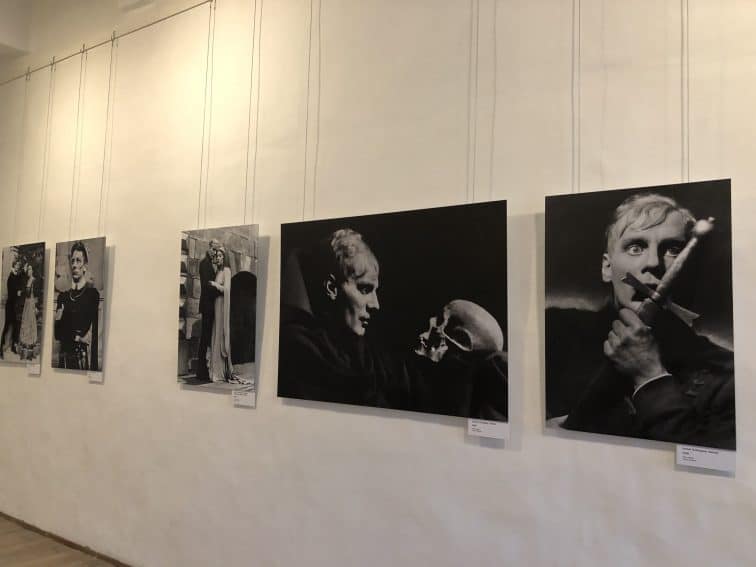
It is in the castle chapel where visitors can get a true picture of what the ballroom and other destroyed areas of the castle might have looked like.
The Chapel is the lone building that survived the fire of 1629. We saw the original Renaissance altar, pews and gallery, all with intact painted panels and magnificent woodcarvings.
The History of Hamlet
It was then time to see the rooms devoted to Hamlet. In 1816 to commemorate the 200th anniversary of Shakespeare’s demise, the play was performed for the first time at Kronborg. Since then a performance has been held here annually.
Luminaries from Laurence Olivier to Christopher Plummer to Jude Law have all played the role of Hamlet, the Prince of Denmark on the grounds of the castle.
Seeing the room full of portraits of movie stars and theater actors playing Hamlet at Kronborg made me think that certainly, the month of August would be the best time to visit.
For it is in the first two weeks of August that Kronborg hosts its Shakespeare Festival or HamletScenen every year.
A Bite to Eat

Finishing up at the castle and deciding to feed our steadily hungry stomachs, we stopped to sample traditional Danish cuisines like smørrebørd and fiskefrikadeller or fishcakes at the café at The Culture Yard.
Located in the historic shipyard harbor and just a few steps from the castle, the expansive glass arcaded space is a cultural center enclosed within old shipyard buildings with a library, exhibition space and concert halls.
This modern waterfront cultural center opened in 2010 and I felt it provided a pleasing visual foil to the ancient castle in the background. The café Spisehuset provided us with a striking view of the fortress, the marina, and the faraway Swedish coast. We were thrilled to see the mist rolling in over the seascape and the stunning castle dramatically disappearing from sight within a few minutes.
A Quick Stroll

As the weather turned bone-chillingly cold, we decided to do a quick walk around the harbor to take in a few other sights. Almost invisible and below ground overlooking Kronborg Castle is the M/S Maritime Museum of Denmark.
Another new addition to the area around Kronborg Castle, this museum opened in 2013 replacing the old museum located inside the castle. The museum exemplifies the trademarks of modern Scandinavian architecture – austere, minimalistic and functional.
Prohibited from sticking out over ground level so as not to block the view of the castle, the prominent Danish architectural firm, BIG – Bjarke Ingels Group cleverly built the museum around an old concrete dry dock.
I was fascinated to see the glass and aluminum-clad stairs and bridges crisscrossing the top giving it the shape of a sunken ship. But what was the most awful part for me? The fact that the whole space was under renovation and surrounded by scaffolding made it impossible for me to click a picture!
With swirling mist enveloping the entire area, we decided to walk back to the train station. Along the way, we admired from afar the male interpretation of the Danish icon, “The Little Mermaid”.
“Han”, the Danish word for “he”, is a shiny stainless steel sculpture at the waterfront jetty and is in the same seated position as his world-famous female counterpart but is certainly an oddity in its surroundings.
However, it did bring a smile to our freezing, tired faces. Later on, I would find out that this sculpture, which was commissioned by the city in 2012, has a unique capability that we missed experiencing. If you decide to visit Helsingor, wait to see the statue blink for a second every hour!
We stopped by in the town square, cobblestoned and enclosed by buildings at least 300 years old. The green spire of St. Olaf Church, completed in 1559, looked beautiful peeking out from behind the colorful blue, yellow and cream facades of local houses.
We went to Helsingor to see Hamlet’s castle and discovered so much more. I wished we could spend a few more hours in this picturesque town but that was not to be and soon we were back in the train returning to Copenhagen.
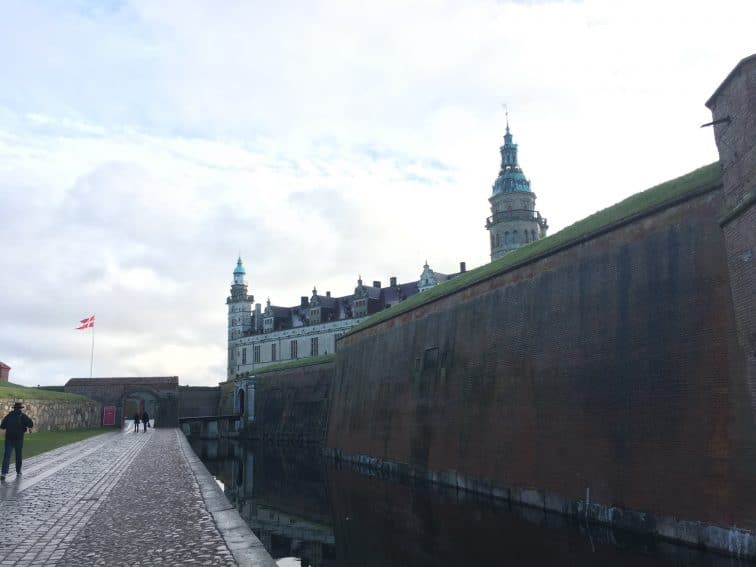
A Useful Tip
We used the Copenhagen Card for this excursion. This is an incredible way to see the sights as it offers discounts and free entries to a variety of attractions. We bought three individual adult cards that allowed us entry not just to all tourist spots in Copenhagen but also for trips such as this, namely day trips from the city.
It also covered ticket prices for all public transportation and regional trains such as the one we used to get to Helsingor: https://copenhagencard.com/
More Information
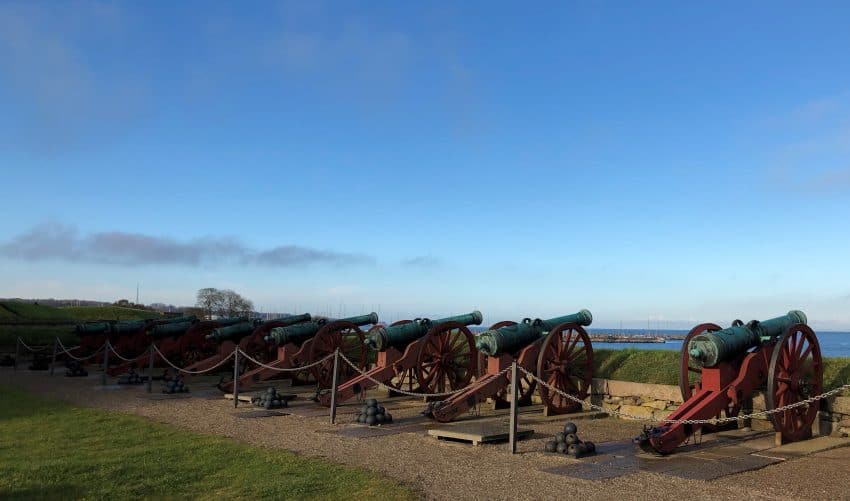
For information on Kronborg Castle
Ticket prices to the castle vary from DKK 90 (Adult) until May 2018 to DKK 140 (Adult) for the months of June – August 2018
Information on the Maritime Museum
A City Guide
For an excellent detailed guide to the city of Helsingor, do read the GoNomad post by Jennifer Wattam Klit.
Susmita Sengupta is a freelance writer who loves to travel. She and her family have traveled to various parts of the USA, Canada, Europe, the Caribbean, Middle East, Southeast Asia and India. She lives in New York City with her family.
Eurail Passes: What to Know about Buying a Europe Train Pass
- These 9 U.S. National Parks Require Reservations in 2024 - April 17, 2024
- Take a Hike in Olympic National Park - April 17, 2024
- The Wild Mississippi: 2340 Miles Across Ten States - April 8, 2024



Hi Susmita
I like your post about your interesting travel story to Denmark which is the small city of Helsingor, I like your great memory at Danish castle and how you take our minds to this far historical heritage as you give us full description about it from in and outside also like cannon sculpture, Also its funny to share us your restaurant experience
Thanks alot
Thank you !